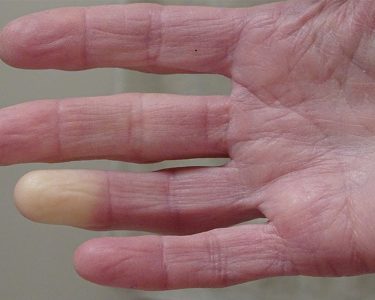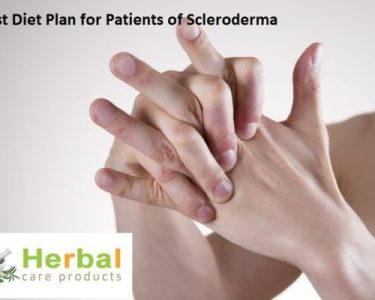Scleroderma
Scleroderma is a category of disorders characterised by the hardening and tightening of the skin and, in some cases, internal organs. Scleroderma is a medical term that literally means “hard skin.” It occurs when the body produces an excessive amount of collagen, a protein that makes up connective tissues.
Scleroderma that affects only the hands and face is known as localised scleroderma. Systemic scleroderma is a more dangerous form of scleroderma that damages connective tissue throughout your body, including your internal organs.
Scleroderma is an autoimmune illness, which means that the immune system destroys the body’s own tissues by mistake. Scleroderma affects roughly 300,000 people in the United States, according to the Scleroderma Foundation. It affects more women than men.
6 Natural Treatments for Scleroderma
Although there is no one-size-fits-all treatment for scleroderma, several natural therapies can assist to reduce the damage to specific organs. Nutrition, pain, physical disuse, and mental elements of the disease (such as social seclusion, fear, and sadness), according to researchers, can be beneficial to the patient. With that in mind, here are some natural ways to ease scleroderma’s mental and physical symptoms:
1. Physical Therapy
Patients with tight and aching joints may benefit from physical therapy. Physical therapy can help prevent joint mobility loss, which occurs when blood flow is reduced and your skin gets tense. Stretching the fingers, hands, wrists, and shoulders are examples of exercises that promote range of motion. When working with scleroderma patients, it’s also vital to strengthen the fingers and hands. Grip strength can be improved by doing exercises like squeezing putty or rice.
Physical therapy can also assist a scleroderma patient execute daily activities in a way that is gentle on his or her joints. Patients frequently practise their stretching routine at home to keep their joints from stiffening. Splints are also utilised to avoid contractures and loss of range of motion. When muscles, tendons, or tissue stiffen, the joints become inflexible or distorted.
2. Reduce Pain with Exercise
According to studies, 60 to 83 percent of scleroderma patients report pain that impairs their physical and social performance. Because the pain associated with scleroderma is variable, affecting different parts of the body and varying in intensity, there is no one-size-fits-all solution for pain treatment.
Physical activity can assist to relieve pain by releasing muscle tension, boosting circulation, and extending and strengthening your joints if you are able to do so. If appropriate, try low-impact exercises such as swimming, water aerobics, strolling, cycling, using an elliptical, and yoga.
Talk to your doctor or physical therapist about your restrictions and the best method for your body before beginning to use exercise as a natural cure for joint pain. According to a recent study published in Disability and Rehabilitation, around half of people with both restricted and diffuse scleroderma exercise by walking. Patients, on the other hand, participate in a wide range of exercise-related activities. Individually developed exercise regimens, according to researchers, are the most likely to support and encourage physical activity in scleroderma patients.
3. Moisturize the Skin
Because scleroderma patients have dry, tight, and thick skin, keeping it moisturised can be beneficial. As soon as you come out of the bath or shower, moisturise your entire body. Coconut oil, olive oil, and almond oil are all excellent natural moisturisers. Essential oils containing menthol can assist to alleviate inflammation, itching, and pain by acting as a cooling agent. Combine 12 teaspoon coconut oil with 1–2 drops of peppermint oil. Apply the mixture to the affected region topically. Before applying peppermint to a larger area, do a patch test on a tiny area of skin to ensure that it isn’t irritating.
It’s critical to avoid strong soaps, laundry detergents, and household cleaners that contain harmful compounds that might exacerbate symptoms. Taking really hot showers or baths, as well as spending too much time in the sun, can dry up the skin. Using a humidifier during the cold months can also be beneficial.
4. Remove Triggers and Eat Healing Foods
According to studies, roughly 30% of scleroderma patients are at risk of malnutrition, and gastrointestinal issues are the major cause of death in 5–10% of patients. Nutritional intervention, which improves gastrointestinal symptoms and quality of life, should be included in the multidisciplinary treatment plan for patients.
Because scleroderma is an autoimmune illness, any food triggers that produce an immunological reaction and inflammation should be avoided. Certain meals might worsen the gastrointestinal tract, which can be affected by scleroderma. Refined carbs, artificial substances, hot foods, alcohol, and caffeine are all examples.
Nutrient malabsorption and dietary allergies are also frequent in patients who have an autoimmune condition. As a result, attempting an elimination diet may assist you in determining which foods trigger an immunological reaction.
Adding healing items to your diet is the next stage. The following are some of the greatest foods to eat to help your body heal and minimise inflammation:
- fresh vegetables, like asparagus, beets, broccoli, carrots, celery, cucumbers, leafy greens, mushrooms and squash
- berries, like blueberries, blackberries, goji berries, raspberries and strawberries
- wild-caught fish, including salmon, halibut and mackerel (avoid shellfish)
- organic, grass-fed meat, such as beef, bison, chicken, turkey, lamb and eggs
- organic, raw dairy, like A2 cow’s milk, goat milk, goat cheese and kefir
- healthy fats, like avocados, coconut oil, coconut milk, grass-fed butter, olive oil and almond oil
- nuts and seeds, including almonds, pecans, pistachios, walnuts, chia seeds, flaxseeds, pumpkin seeds, nut butter and seed butter
- spices and herbs, like basil, cilantro, cinnamon, cumin, garlic, ginger, oregano, rosemary and turmeric
5. Take (or Eat) Probiotics
Because probiotics aid in the repair of your stomach and tissues, they may aid in the relief of scleroderma symptoms. Leaky gut may provide a unifying theory for most autoimmune disorders, according to a growing body of evidence. The microbiome is important in keeping the immune system in check so that too many antibodies are produced. Good bacteria in the gut aid in the restoration of a balance between pro-inflammatory and anti-inflammatory immune cells.
Probiotics dramatically alleviate reflux and bloating in scleroderma patients, according to research conducted at the University of Utah. After two months of daily probiotic use, the participants noted considerable results.
The best strategy to restore the balance of bacteria in your stomach is to take a probiotic supplement or eat probiotic foods. Kefir, kombucha, yoghurt, cultured vegetables, apple cider vinegar, and tempeh are some of the greatest probiotic foods.
6. Seek Counseling or Support
There is a lot of research that shows the numerous issues that persons with scleroderma encounter. Anxiety, depression, and body image difficulties are all frequent psychological problems among patients. Peer support has been shown in studies to be a beneficial initial step in reducing depression symptoms because patients are able to discuss openly with someone who has dealt with similar issues. Support groups over the phone or on the internet are more common. According to study, they are more well-attended than face-to-face gatherings, owing to their flexibility and privacy.
Scleroderma sufferers have also found that cognitive behavioural therapy and social skills training programmes are useful and beneficial. These treatments assist patients in dealing with anxiety brought on by social interactions and concerns about their appearance. Know that you are not alone if you have scleroderma, and there are many support groups available to assist you cope with the physical changes you are going through.




